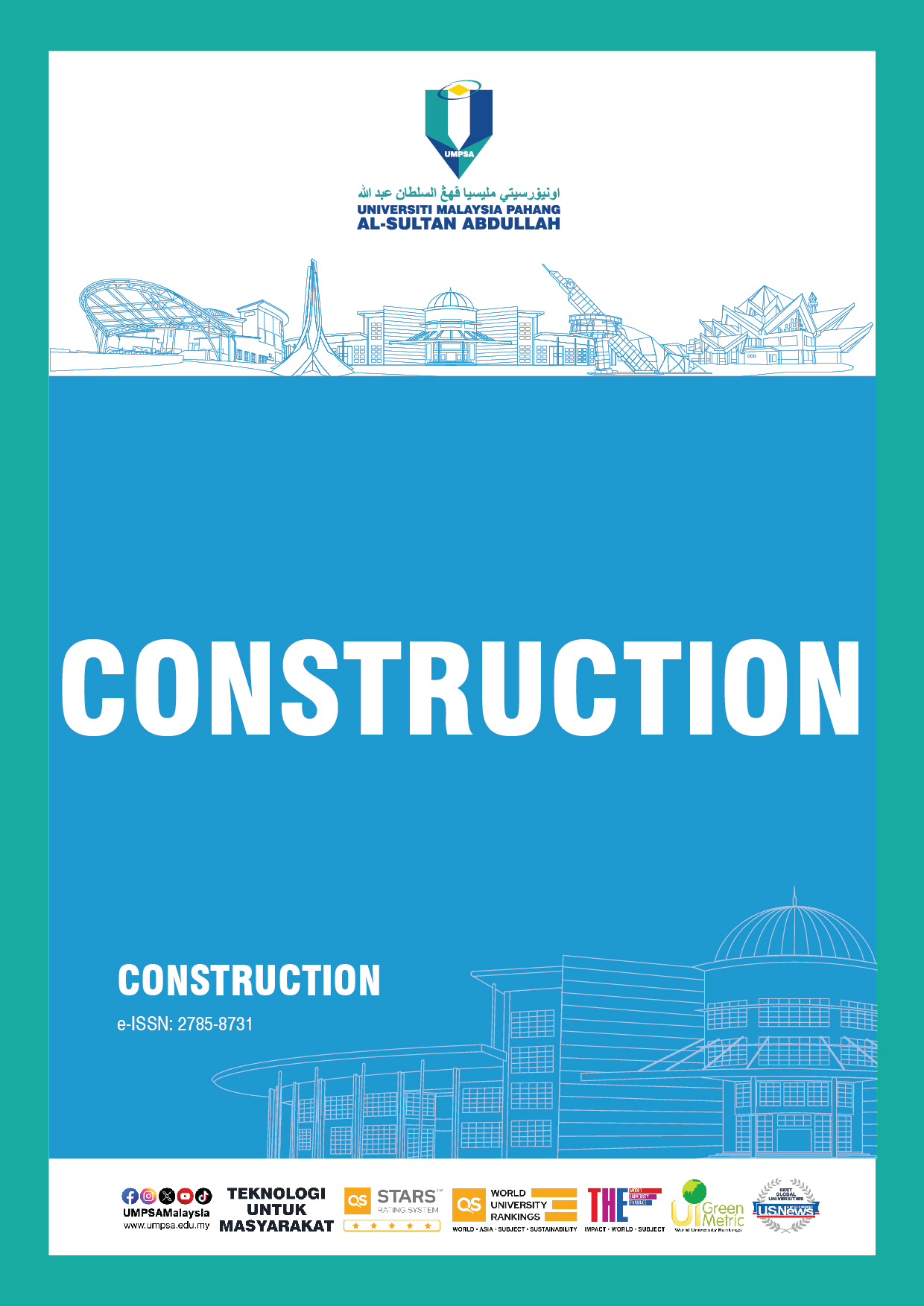Distribution Mapping of Building Classification and Air Pollution Exposure in the Urban City Areas by Using GIS-Based Application: A Pilot Study
DOI:
https://doi.org/10.15282/construction.v4i2.11378Keywords:
Building, Air pollution, Particulate matter, Urban, GISAbstract
This study explores the association between the locations of building classification and air pollution, focusing on the particulate matter concentrations (PM2.5) in Kuantan city. It emphasizes the influence of building classification on selected locations in the urban city area and PM2.5-related health hazards. PM2.5 were measured at selected areas that have been classified as high-rise and low-rise building areas in the Kuantan city centre. The selected study locations were also mapped with the GIS mobile application to have a better understanding through visualization. Locations that has been identified as the high-rise buildings area had a greater PM2.5 concentrations than the low-rise buildings area due to constrained airflow. To minimize the PM2.5 pollution, it is recommended to consider building design, air pollutant dispersion strategies, and introducing green spaces in the urban city area. A further study is needed to address these mitigation factors to improve the ambient air quality in the urban city area.
Downloads
References
[1] S. Kumar Mohapatra, S. Mishra, H.K. Tripathy, A. Alkhayyat, “A sustainable data-driven energy consumption assessment model for building infrastructures in resource constraint environment,” Sustainable Energy Technologies and Assessments, vol. 53, p. 102697, 2022.
[2] C. Mir Alvarez, R. Hourcade, B. Lefebvre, E. Pilot, “A scoping review on air quality monitoring, policy and health in West African cities,” International Journal of Environmental Research and Public Health, vol. 17, no. 23, p. 9151, 2020.
[3] E. Orsetti, N. Tollin, M. Lehmann, V.A. Valderrama, J. Morató, “Building resilient cities: Climate change and health interlinkages in the planning of public spaces,” International Journal of Environmental Research and Public Health, vol. 19, no. 3, p. 1355, 2022.
[4] R. Cao, B. Li, Z. Wang, Z.R. Peng, S. Tao, S. Lou, “Using a distributed air sensor network to investigate the spatiotemporal patterns of PM2. 5 concentrations,” Environmental Pollution, vol. 264, p. 114549, 2020.
[5] R. Lepenies, I.S. Zakari, “Citizen science for transformative air quality policy in Germany and Niger”. Sustainability, vol. 13, no. 7, p. 3973, 2021.
[6] L.E. Cummings, J.D. Stewart, P. Kremer, K.M. Shakya, “Predicting citywide distribution of air pollution using mobile monitoring and three-dimensional urban structure,” Sustainable Cities and Society, vol. 76, p. 103510, 2021.
[7] Law Insider, “Infrastructure building Definition | Law Insider,” https://www.lawinsider.com/dictionary/-infrastructure-building
[8] Britannica, “Low-rise residential buildings Britannica,” https://www.britannica.com/technology/construction/-Low-rise- residential-buildings, 2019.
[9] S. Feng, D. Gao, F. Liao, F. Zhou, X. Wang, “The health effects of ambient PM2.5 and potential mechanisms,” Ecotoxicology and Environmental Safety, vol. 128, pp. 67–74, 2016.
[10] M.E. Goodsite, O. Hertel, “Urban air quality urban air quality: Sources urban air quality sources and Concentrations urban air quality concentrations,” Encyclopedia of Sustainability Science and Technology, pp. 11291–11311, 2019.
[11] US EPA, “Health and environmental effects of Particulate Matter (PM) US EPA,” https://www.epa.gov/pm-pollution/health-and-environmental-effects- particulate-matter-pm, 2022.
[12] B. Giyasov, I. Giyasova, “The impact of high-rise buildings on the living environment,” E3S Web of Conferences, vol. 33, p. 01045, 2019.
[13] Kuantan City Council, Kuantan, Retrieved from https://mbk.gov.my/portal/en/, 2021.
[14] East Coast Economic Region Development Council, Kuantan Conurbation identified as a key growth centre, 2011. Retrieved from https://www.ecerdc.com.my
[15] J. Yang, B. Shi, Y. Shi, S. Marvin, Y. Zheng, G. Xia, “Air pollution dispersal in high density urban areas: Research on the triadic relation of wind, air pollution, and urban form,” Sustainable Cities and Society. 54, 101941. 2019.
[16] Y. Zhang, K.C.S. Kwok, X.P. Liu, J.L. Niu, “Characteristics of air pollutant dispersion around a high-rise building,” Environmental Pollution, vol. 204, pp. 280-288, 2015.
[17] M. Wu, G. Zhang, L. Wang, X. Liu, Z. Wu, “Influencing factors on airflow and pollutant dispersion around buildings under the combined effect of wind and buoyancy-A review,” International Journal of Environmental Research and Public Health, vol. 19, no. 19, p. 12895, 2022.
[18] Y. Yu, K.C.S. Kwok, X. Liu, Y. Zhang, “Air pollutant dispersion around high-rise buildings under different angles of wind incidence,” Journal of Wind Engineering and Industrial Aerodynamics, vol. 167, pp. 51-61, 2017.
[19] H. Miloua, “Design and construction criteria of twin tunnel: Taking an adverse wind condition effects on air pollution short circuit at tunnel portals as a case,” Journal of Building Materials and Structures, vol. 7, no. 1, pp. 1-18, 2020.
[20] P. Roy, Towards CFD investigations into particulate air pollution of a desert urban environment, digitalscholarship.unlv.edu, 2023.
[21] R. Buccolieri, O.S. Carlo, E. Rivas, J.L. Santiago, P. Salizzoni, M.S. Siddiqui, “Obstacles influence on existing urban canyon ventilation and air pollutant concentration: A review of potential measures,” Building and Environment, vol. 214, p. 108905, 2022.
Downloads
Published
Issue
Section
License
Copyright (c) 2024 The Author(s)

This work is licensed under a Creative Commons Attribution-NonCommercial 4.0 International License.




